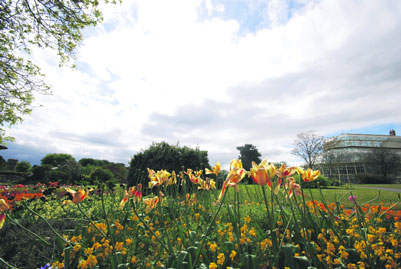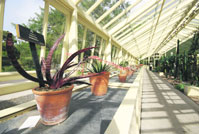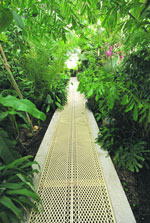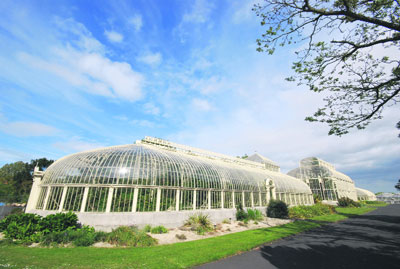Ireland's economic bloom
Emma Browne takes a stroll around the Botanic Gardens in Dublin. Photos by Eoin Moylan
With all the criticism Bertie Ahern has been getting recently about his finances, his party's overspending in government and their broken promises, there is a less-highlighted positive that has come out of his 10-year reign as Taoiseach – the rehabilitation of the National Botanic Gardens.
Situated in Bertie's home constituency of Dublin Central, the gardens were in dire need of public funding in the early-1990s. The historic glasshouses, built in the 19th Century, were in disrepair and the outbuildings neglected. But partly as a result of Bertie becoming Taoiseach, the funding has improved and in the last 10 years, the glasshouses have been refurbished and a new reception area, cafe and Herbarium have been built. Plant specimens have been collected from far afield and the gardens have been vastly developed.
First opened in 1795 by the Royal Dublin Society, the original purpose of the National Botanic Gardens was to show the landed gentry what kind of plants they could grow in Ireland. The gardens were spread over 11 hectares in North Dublin. In 1877, the government took control of the gardens and they now stretch to 19 hectares. The present plant population includes 20,000 species, Irish and foreign. There is a massive collection of dried plants in the Herbarium – over 750,000 dried pressed plants including many Irish plants that are now extinct, or may still exist but have never been found to date.

According to the curator of the Herbarium, Matthew Jebb, “Everything we need to know about Irish plant life is in that Herbarium, among the pressed plants.”
There are also some unique specimens in the Herbarium. One is a gigantic seed collected from the Congo by Sir Roger Casement. It takes nine years to fully grow into biggest seed in the world. It used to be so valuable it was worth more than its weight in gold. In August 2007, the gardens will be displaying some of these unusual items to the public.
Another fascinating specimen in the gardens is a pine tree in the Curvilinear glasshouse. The tree, housed in a cage, was only discovered seven years ago outside Sydney and has a fossil life that goes back 100 million years. On loan from Australia, the authorities there are insisting it is kept in a cage so it is not stolen. But, ironically, there are 20 more out the back of the gardens which are not caged and await plantation around Ireland.
 The gardens are designed to show visitors the wealth of species that can grow in Ireland. As well as Irish plants, the gardens contain plants from Asia, China in particular, brought back by garden staff in the last few years.
The gardens are designed to show visitors the wealth of species that can grow in Ireland. As well as Irish plants, the gardens contain plants from Asia, China in particular, brought back by garden staff in the last few years.
The gardens are divided into sections either by country or species of plant. There is the Irish bed, the cherry-blossom lawn, the rose garden, the tulip bed, the daffodil bed – there are 25,000 daffodils in the gardens. As well as this, there are two large glasshouses which dominate the gardens.
Interestingly, they have have laid out a series of plant beds in chronological and evolutionary order. These begin with the earliest types, for instance ferns, and run up to grasses, which are much younger. At the moment, they just look like normal beds to the visitor as they have not been mapped out and signposted, but this should be completed soon.
The layout of the gardens is clever and easy to understand. It gives a fascinating insight into plant life. Matthew Jebb explained that one of the beds holds species of the Magnolia plant, which was the earliest flowering plant and has changed little in 80,000 million years. At that time on earth, the only flying insects were beetles and dragonflies, and to this day the Magnolia is pollinated by beetles.
 Much of the important work goes on behind the scenes in the Herbarium – studying Irish plants, discovering new plants and developing the gardens. One remarkable thing that studies there have shown is the effect of global warming on the gardens and plant life in Ireland.
Much of the important work goes on behind the scenes in the Herbarium – studying Irish plants, discovering new plants and developing the gardens. One remarkable thing that studies there have shown is the effect of global warming on the gardens and plant life in Ireland.
Every year, the staff monitor the time of year when trees bud in Spring or the leaves start falling in Autumn. From this, they have discovered over a 20-year period that the season for plant life in the gardens has lengthened by 15 days, a week each Spring and Autumn. This is most likely due to warmer temperatures.
The Irish section of the gardens recreates a mini-Burren plant life. Due to its unique climate, the Burren is the only habitat in the world to bear plants from the Arctic Circle and the Mediterranean coast area – it is in a northern part of the world but with warm winds from the Gulf Stream. At present, the gardens are developing a larger Irish section with more peat land and bog plant life.
But perhaps the most amazing features of the gardens are not plants at all, but the colossal glasshouses, built in the 19th Century. There are two structures – the Palm House range and the Curvilinear range, built in 1869 and 1884 respectively. The houses were built by Richard Turner, an Irish glasshouse designer, who also built the glasshouses in the Kew Gardens and the Winter Gardens at Regent's Park in Britain. He was also involved with the first iron roof to cover a railway terminus in a single span at Lime Street, Liverpool. He was the first person who was able to build such large glasshouses, having developed a way of using wrought iron and cast iron to give a curve, which was needed for the roof.
The houses had fallen into disrepair in the early-1990s but have been restored meticulously. The Curvilinear range was restored in 1995 using some of the original ironwork and glass from the Kew Gardens building, which was being restored at that time. The Palm House was renovated in 2004, and amazingly since then the tropical plants inside have grown to huge heights. The monkey tree in there has grown 13ft in 12 months.
The gardens run a range of exhibitions and talks during the year. An interesting one coming up this year is on Carl Linnaeus, the man who named the human race, Homo sapiens, and who devised a categorisation of plant life still used to this day. To celebrate his 300th birthday, there will be talks in August.
For more information, visit www.botanicgardens.ie

